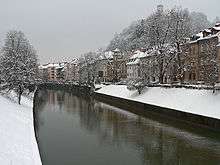Ljubljanica
| Ljubljanica | |
|---|---|
 The Ljubljanica flows through Ljubljana. | |
| Country | Slovenia |
| Basin | |
| Main source |
Retovje45°57′5.28″N 14°17′40.54″E / 45.9514667°N 14.2945944°E, Ljubija45°57′11.32″N 14°18′0.16″E / 45.9531444°N 14.3000444°E, Bistra 300 m (980 ft)[1] 45°56′51″N 14°20′2.84″E / 45.94750°N 14.3341222°E |
| River mouth |
Podgrad 260 m (850 ft)[1] 46°4′10.93″N 14°38′19.74″E / 46.0697028°N 14.6388167°ECoordinates: 46°4′10.93″N 14°38′19.74″E / 46.0697028°N 14.6388167°E |
| Basin size | 1,860 km2 (720 sq mi)[2] |
| Physical characteristics | |
| Length | 41 km (25 mi) (including Little Ljubljanica)[1] |
| Discharge |
|
The Ljubljanica (pronounced [ljuˈbljaːnitsa]), known in the Middle Ages as the Ljubija, is a river in the southern part of the Ljubljana Basin in Slovenia. The capital of Slovenia, Ljubljana, lies on the river. The Ljubljanica rises south of the town of Vrhnika and outflows in the Sava River about 10 kilometres (6.2 mi) downstream from Ljubljana. Its largest affluent is the Mali Graben Canal.[3] Including its source affluent the Little Ljubljanica (Slovene: Mala Ljubljanica), the river is 41 km (25 mi) in length.[1] The Little Ljubljanica joins the Big Ljubljanica (Slovene: Velika Ljubljanica) after 1,300 m (4,300 ft) and the river continues its course as the Ljubljanica.
The Ljubljanica is the continuation of several karst rivers that flow from the Prezid Karst Field (Slovene: Prezidsko polje) to Vrhnika on the surface and underground in caves, and so the river is poetically said to have seven names (six name changes): Trbuhovica, Obrh, Stržen, Rak, Pivka, Unica, and Ljubljanica.
Archaeological significance
The Ljubljanica has become a popular site for archaeologists and treasure hunters to dive for lost relics and artifacts. Locations in the river between Ljubljana and Vrhnika have offered up pieces of history from the Stone Age to the Renaissance, belonging to a variety of groups, from local ancient cultures to more well-known groups like the Romans and the Celts.[4] One of the more significant findings is a yew spearhead, found in 2009 in Sinja Gorica. It has been dated to about 35,000 to 45,000 before present, the Szeletien period, and supplements the scant data about the presence of Stone Age hunters in the Ljubljana Marshes area.[5]
Exactly why the Ljubljanica became an article dumping ground is unknown, but most historians believe that it is related to how local tradition has always held the river as a sacred place. These treasures may have been offered "to the river during rites of passage, in mourning, or as thanksgiving for battles won."
The Ljubljanica has become a popular attraction in Europe for treasure hunters. This has created an ethical debate between local historians and international treasure seekers. It is believed that the river has offered up between 10,000 and 13,000 objects, of which many have been lost to the public. Many pieces have been sold into private collections, or are hidden away by the original treasure hunters. In 2003, to help curb this trend, Slovenia's national parliament declared the river a site of cultural importance and banned diving in it without a permit.
Gallery
 The Ljubljanica at Nove Fužine
The Ljubljanica at Nove Fužine- Night view of the river
- Reflection of houses at the Cankar Embankment
 Center of Ljubljana with Annunciation Church in the background
Center of Ljubljana with Annunciation Church in the background The Ljubljanica from the Cobbler Bridge in Ljubljana
The Ljubljanica from the Cobbler Bridge in Ljubljana One of the springs of the Ljubljanica at Bistra Castle near Vrhnika
One of the springs of the Ljubljanica at Bistra Castle near Vrhnika View of Ljubljana from the Ljubljanica
View of Ljubljana from the Ljubljanica
See also
References
- 1 2 3 4 "Reke, dolge nad 25 km, in njihova padavinska območja" [Rivers, longer than 25 km, and their catchment areas] (in Slovenian and English). Statistical Office of the Republic of Slovenia. 2002.
- ↑ "Main Hydrographic Features in the Sava River Basin". Sava River Basis Analysis Report (PDF). Zagreb: International Sava River Basin Commission. September 2009. p. 13.
- ↑ "Občinski program varnosti občine Brezovica" [Municipal programme of the Municipality of Brezovica] (in Slovenian). 2010. p. 35. Retrieved 20 September 2010.
- ↑ Kaufmann, Carol (Jan 2007). "A River's Gifts". National Geographic Magazine. 150-7.
- ↑ "Na Barju našli leseno ost sulice, staro 38.000 do 45.000 let" [A 38,000 to 45,000 Year Old Wooden Spearhead Found in the Ljubljana Marshes] (in Slovenian). Slovenian Press Agency. 6 May 2009. Retrieved 7 January 2011.
External links
| Wikimedia Commons has media related to Ljubljanica. |
- Condition of Ljubljanica - graphs, in the following order, of water level, flow and temperature data for the past 30 days (taken in Moste by ARSO)
- http://expo98.literal.si/eng/zakladi/vode-slovenije/ljubljanica.html
- http://www7.nationalgeographic.com/ngm/0701/feature6/index.html
